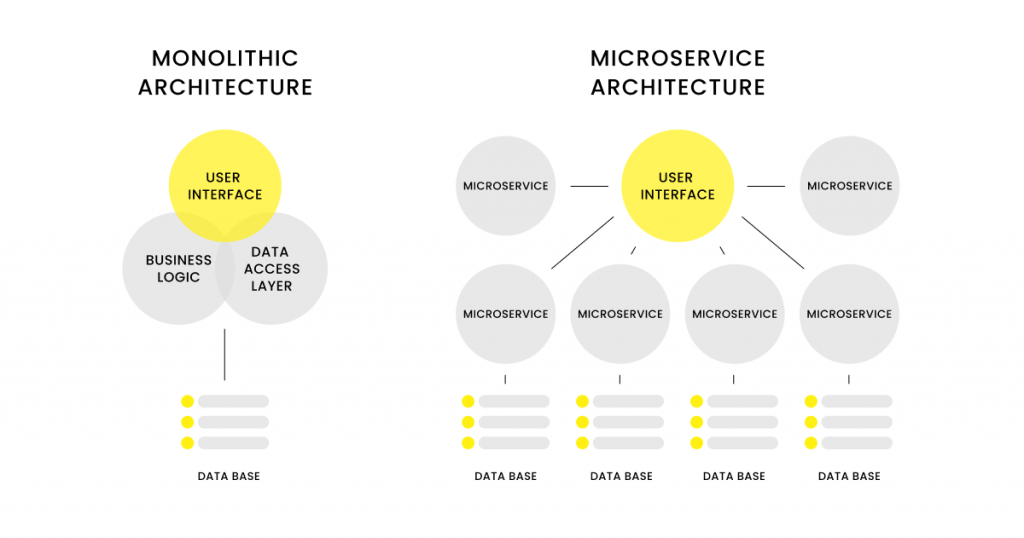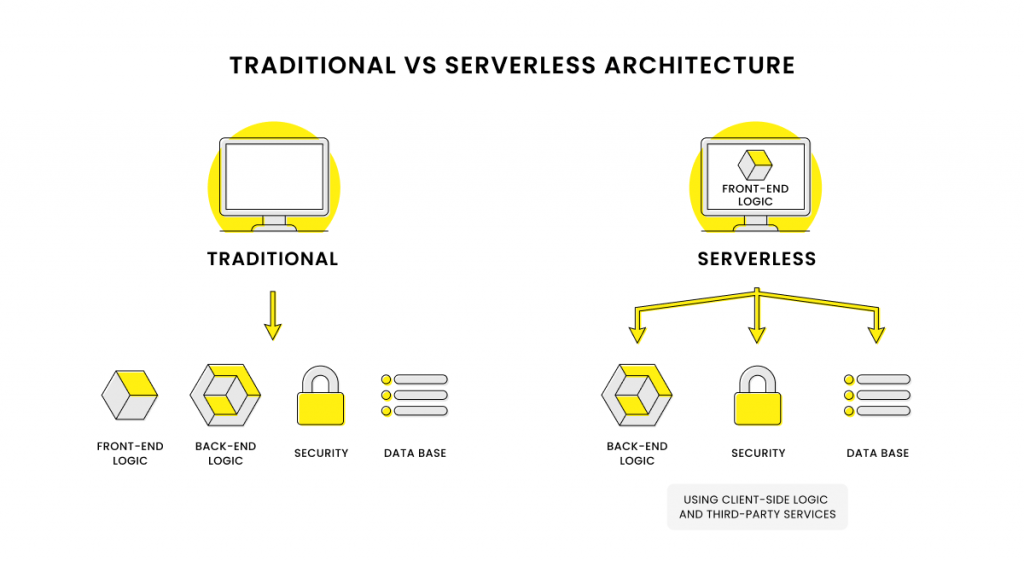Software architecture is the backbone of the whole system that helps to organize your software. How to choose the right one for an IT project? We compare top architecture solutions for building applications: serverless and microservices, focusing on their pros and cons.
Software architecture is the core of the whole project, and it determines many aspects of an IT project, such as the choice of tech stack. If it is badly designed, it can lead to the software’s total collapse. Hence, following stable software architecture solutions, such as microservices or serverless, will bring the best results. However, how to choose the one that will guarantee that your digital product meets all business needs?
Table of Contents
Things you will learn
In this article, we’ll define what software architecture exactly is and how it can foster the effectiveness of your digital product in terms of enterprise functionality. Moreover, we’ll outline the process of developing applications based on two architecture patterns: microservices and serverless. Let’s find out:
- What software architecture is and how it differs from software design,
- The most common software architecture patterns with their pros and cons,
- How to choose the right architecture pattern for your IT project.
What is Software Architecture?
First of all, let’s define the term software architecture. Simply put, it is the process of creating a software system’s structure at a high level. The proper structure enables every IT solution to meet all the operational and business assumptions. It influences software quality, maintenance, and functioning. In general, software architecture has an impact on the product’s final success.
Software Architecture vs. Software Design
A lot of people, even programmers, sometimes confuse software architecture and system design. As there are some similar aspects that overlap, it’s hard to distinguish between these two terms.
Pro tip: Don’t confuse software architecture with software design
Let’s clarify the difference between these two terms:
- Software design is a process of designing individual modules or components and their interaction with one another. In other words, software design is about planning the system’s implementation. Hence, it is often the initial stage in the whole Software Development Life Cycle (SDLC).
- Software architecture refers to the process of converting software characteristics such as flexibility, scalability, feasibility, reusability, and security into a structured solution that meets technical and business expectations.
Serverless vs Microservices Software Architecture – Comparison
Over the years, software architects have designed many ways of how data should flow through software. Among different architecture patterns, we’ll focus on the two common options: serverless and microservices. We’ll compare these two approaches providing their short characteristics, as well as strengths and weaknesses.
Pro tip: You can use different architecture patterns within a single software system in order to provide each part of the code with the best possible solution.
Microservices Architecture
Microservices have huge potential in terms of application development. First of all, they enable incorporating all the changes within the software without any side effects. The microservice architecture works on the principle of componentization of services. Let’s take a look at its definition:
In short, the microservice architectural style is an approach to developing a single application as a suite of small services, each running in its own process and communicating with lightweight mechanisms, often an HTTP resource API.
– James Lewis and Martin Fowler (2014)
Microservice architecture is designed to prevent systems from growing up to be monolithic and inflexible. In other words, it allows for creating various smaller programs instead of constructing one big mechanism. It enables generating a microprogram every time you develop a new feature.

The graphic visualization above illustrates the difference between monolithic and microservice architecture. When should you use the microservices architectural style? Let’s take a closer look at its pros and cons to understand when it turns out the most useful.
Pros:
- Efficient modular structure – microservices architecture involves modular structure, which is extremely beneficial, especially for large IT projects. The modular approach fosters workflow – your team can easily update or swap modules without causing harm to the whole system.
- Greater autonomy – Since microservices are deployed independently, making improvements within the project becomes much easier and gives the team more autonomy.
- Technology diversity – you can choose different technology to create every microservice. Needless to say, it gives your team the freedom to experiment and go for top-notch languages or frameworks.
Cons:
- Difficult communication between services – It’s hard to maintain good communication flow within an application that is split into multiple modules. It increases the risk of disrupted communication between services.
- It’s hard to achieve consistency – in a microservice architecture model, each microservice has got its own API. The whole network of microservices and their APIs enables maintaining consistency within an application. However, control over the interface in a distributed system with such a large number of APIs is super hard to maintain.
- High complexity – creating, deploying, and managing so many services makes a microservice-oriented architecture a very complex solution. Thus, you need the support of orchestration frameworks, such as Kubernetes that enables running a huge amount of microservices.

You can discover 5 Advantages of a Kafka-centric Microservice Architecture:
5 Advantages of a Kafka-centric Microservice Architecture
Serverless Architecture
Serverless architecture in software design enables the creation of applications and services without the need to manage their infrastructure. This is the cloud solution that involves third-party integration. As a result, developers can focus on writing and deploying code, while the cloud provider takes care of the proper server’s functioning. The serverless architecture model can be divided into two main categories:
- Backend as a service (BaaS)
- Functions as a Service (FaaS)
- Infrastructure as a service (or IaaS)
The most famous provider for serverless API is Amazon AWS Lambda. The serverless architecture solution saves time and increases enterprise efficiency. Why? Since you don’t have to devote your time to set up a server, you can focus on other important issues, such as will help you save a lot of time taking care of and fixing bugs.

Pro tip: The term serverless architecture can be a little bit confusing. So, be careful not to misuse it. Serverless in this context doesn’t mean that there is no server involved in your system. Another misconception is that serverless architecture can replace microservices. In fact, a third-party provider takes care of managing server infrastructure and microservices architecture for you.
Pros:
- No server management – in serverless computing, the third-party provider is in charge of running and managing the servers for you.
- Cost efficiency – one of the greatest benefits of switching to serverless architecture for IT companies is lowering costs. Cooperating with cloud third-party providers, you pay for particular services.
- Scalability – if you build software on serverless architecture, the system automatically scales.
- Security – if you decide on services from recognized third-party providers, you don’t have to worry about safety issues. Top cloud vendors offer the most secure services.

Find out how to handle security issues in software development:
Security in Software Development – Taking the Right Approach
Cons:
- Single provider – it is certainly possible to pick services from different vendors. However, once you choose a service provider, you will be dependent on their service. It may turn out challenging if you ever want to migrate to a different provider.
- Difficult testing – it is difficult to see how the code will work once deployed because you can not really replicate the serverless environment.
- Cold start – setting off a function for the first time requires the so-called „cold start”. It means that a container needs to be triggered first. Although it can be problematic, there are some proven ways to make it less troublesome, such as: avoiding enormous functions or reducing set-up variables.
Check out our case study on how we helped our client to switch to AWS services.
Serverless vs Microservices: How to choose the right software architecture?
There are a lot of factors that you should consider before making a decision on which software architecture will be the best for your next project. You can select the software architecture in terms of its: costs, reliability, performance, security, and usability. Both serverless and microservices are great technologies, however, they also have some drawbacks. Serverless will definitely be a good solution for startups and mid-sized enterprises, whereas microservices will work well for bigger companies.
If you have any questions, don’t hesitate to contact us — we’ll be more than happy to advise you on your IT issues! For more fresh news from the IT world, visit our blog. Here, we regularly post on technology-related topics.


